-
This community needs YOUR help today. We rely 100% on Supporting Memberships to fund our efforts. With the ever increasing fees of everything, we need help. We need more Supporting Members, today. Please invest back into this community. I will ship a few decals too in addition to all the account perks you get.

Sign up here: https://www.muzzleloadingforum.com/account/upgrades -
Friends, our 2nd Amendment rights are always under attack and the NRA has been a constant for decades in helping fight that fight.
We have partnered with the NRA to offer you a discount on membership and Muzzleloading Forum gets a small percentage too of each membership, so you are supporting both the NRA and us.
Use this link to sign up please; https://membership.nra.org/recruiters/join/XR045103
You are using an out of date browser. It may not display this or other websites correctly.
You should upgrade or use an alternative browser.
You should upgrade or use an alternative browser.
Hamilton Burr duel commemorative set
- Thread starter Brianc
- Start date

Help Support Muzzleloading Forum:
This site may earn a commission from merchant affiliate
links, including eBay, Amazon, and others.
- Joined
- Nov 26, 2005
- Messages
- 5,025
- Reaction score
- 10,003
Hi,
Here is a historically correct cased set with the right accessories usually supplied with Wogdon pistols. There was some variation but most have and oil bottle, flint whisk, powder flask (Wogdon's would be a stiff leather bag flask or leather covered copper. Mine don't have the leather cover. There would be a loading rod with cleaning jag, a two-bladed turnscrew, a bullet mold, perhaps some loose bullets and patches, and sometimes a patch cutter. Usually the case was also supplied with a stiff leather traveling cover.
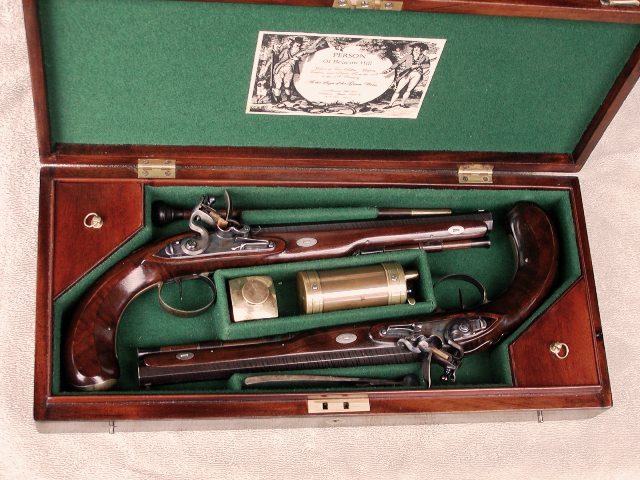
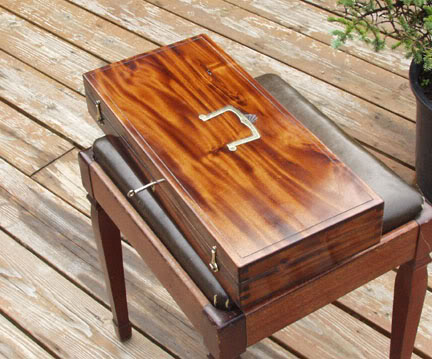
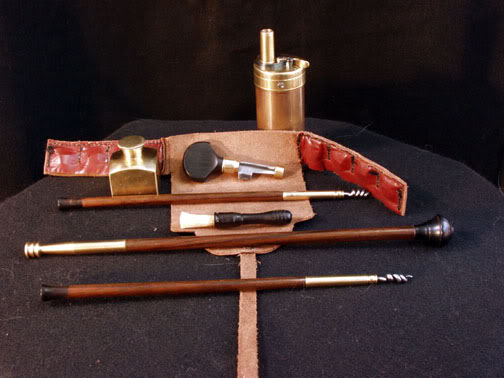
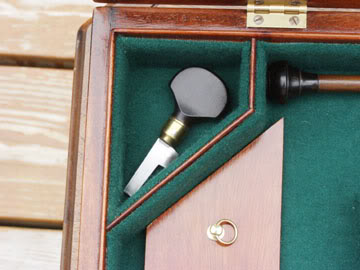
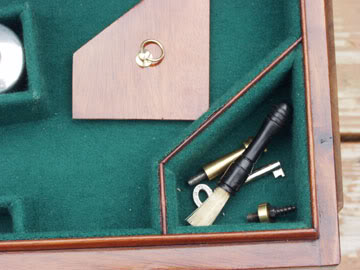
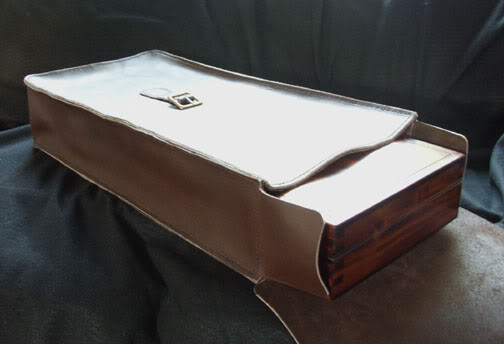
The Burr-Hamilton pistols by Wogdon were originally full stocked in walnut. Someone later added the brass fore stocks because the fashion was for heavier pistols and Wogdons were light and lively.
dave
Here is a historically correct cased set with the right accessories usually supplied with Wogdon pistols. There was some variation but most have and oil bottle, flint whisk, powder flask (Wogdon's would be a stiff leather bag flask or leather covered copper. Mine don't have the leather cover. There would be a loading rod with cleaning jag, a two-bladed turnscrew, a bullet mold, perhaps some loose bullets and patches, and sometimes a patch cutter. Usually the case was also supplied with a stiff leather traveling cover.






The Burr-Hamilton pistols by Wogdon were originally full stocked in walnut. Someone later added the brass fore stocks because the fashion was for heavier pistols and Wogdons were light and lively.
dave
mhb
40 Cal.
- Joined
- Oct 5, 2011
- Messages
- 492
- Reaction score
- 222
As you intend to shoot the pistols, you should know that the brass foreend extensions are attached to the barrels with screws - which are threaded completely through into the bores. The ends of the screws are finished off to match the radius of the bore, and are pretty level with it (so it is hard to detect their intrusion unless you specifically look for it). Still, this is the reason I did not buy a pair of the repro Wogdons, feeling that this method of attachment is incorrect, poor practice, and a likely place for corrosion to start, if not carefully attended to. Also, since the portion of the threads on the body of the screws and the threaded holes where they meet at the bore surface are very thin, I feel that the thin metal would eventually crack-off and leave a noticeable 'divot' in the bore, which would likely tear patches and be an even more likely place for corrosion to take hold. FWIW...
mhb - MIke
mhb - MIke
I actually noticed and wasn’t terribly crazy about the screw going through the bore when i bought them . I clean everything I buy of this nature to preserve it and prevent corrosion. On reassembly I used some choke tube grease on the threads. Originally I had thought there was a lot of rust in the barrels so I refused to pay much, however when I started cleaning the “rust “ was old nasty grease so they’re I pretty nice shape and honestly I doubt I’d ever fire enough to notice a difference. Supposedly the originals were done the same. Thank you for the FYI
- Joined
- Nov 26, 2005
- Messages
- 5,025
- Reaction score
- 10,003
Hi,
I built those pistols and the case. In fact, I made everything except the oil bottle, cleaning jag, and the barrels on the pistols. They are modeled after a pair of Wogdons and the case is laid out as Wogdon designed his cases. The lining is wool baize fabric. You can get oil bottles from Track of the Wolf, Peter Dyson, Dixie Gun Works, and Lewis Drake. The one I used fits the compartment nicely but is actually a little large for a pistol case. Most pistol case oil bottles were smaller and cylindrical. I would love to see photos of the inside of the lock.
dave
I built those pistols and the case. In fact, I made everything except the oil bottle, cleaning jag, and the barrels on the pistols. They are modeled after a pair of Wogdons and the case is laid out as Wogdon designed his cases. The lining is wool baize fabric. You can get oil bottles from Track of the Wolf, Peter Dyson, Dixie Gun Works, and Lewis Drake. The one I used fits the compartment nicely but is actually a little large for a pistol case. Most pistol case oil bottles were smaller and cylindrical. I would love to see photos of the inside of the lock.
dave
BriancThank you for your responses! All suggestions welcome! This stuff is addicting (maybe an intervention is in order?) lol thank you all!
I hate to tell you pardner, but you have contracted the dread GOTTAGETANOTHERGUNITIS a condition for which there is no cure.
It can be mediated somewhat by from time to time purchasing or building another gun but that does not last.
However you have made a great beautiful start..
I have been afflicted by this condition for many years and have almost fun out of room in the gun rack
your fellow sufferer
Bunk.
- Joined
- Oct 17, 2006
- Messages
- 1,180
- Reaction score
- 940
Your duelers were made by Uberti for the U.S. Historical Society and sold in the early 1980's for $3000. Uberti had access to the originals which are owned now by the Chase Manhattan Bank. The brass forends were a later addition to the pistols not as they were when they left Wogdon' s shop and reflect a change in the thoughts on dueling pistols favoring a muzzle heavy weapon to hang better on target. That they are attached by a screw that passes into the bore might concern some but in practicality had no effect in use. I have owned three sets of these duelers and shot one set extensively with no problems. The U.S. Historical society came into being around the bi-centenial and had several sets of historical firearms, all made by Uberti with the exception of the Hege Sieber, that they sold to those with more money than sense as instant collectables sure to appreciate. While these firearms were horrible investments selling at the time in the $3000 range or the equivalent of about $12000 in todays dollars they were made to an exceptionally high standard of quality and are a true bargain at the prices they can be had for today.
As delivered originally they came with a powder flask a few lead balls and a set of white cotton gloves for handeling.
As delivered originally they came with a powder flask a few lead balls and a set of white cotton gloves for handeling.
mhb
40 Cal.
- Joined
- Oct 5, 2011
- Messages
- 492
- Reaction score
- 222
I actually noticed and wasn’t terribly crazy about the screw going through the bore when i bought them . I clean everything I buy of this nature to preserve it and prevent corrosion. On reassembly I used some choke tube grease on the threads. Originally I had thought there was a lot of rust in the barrels so I refused to pay much, however when I started cleaning the “rust “ was old nasty grease so they’re I pretty nice shape and honestly I doubt I’d ever fire enough to notice a difference. Supposedly the originals were done the same. Thank you for the FYI
I feel sure that the alteration on the originals was NOT done in that way. I have never been able to find a very good photo of the original pistols, but the best I have seen appears to show that the brass extension is attached with a wedge or key in exactly the way the original wood stock was. It would have been poor practice then as now to drill an unnecessary hole through into the bore, and I can't believe that any competent gunsmith would have done so. Having said that, I'd be happy to see a quality photo of the original showing exactly how the work was done, or even a statement from the current holders of the pair (Chase-Manhattan Bank?) which would answer the question.
Still, since you are aware of the potential problems, I hope you will enjoy the pistols. Were they mine, and without the objectionable screw and hole, I'd shoot them at every opportunity, as I do all my other original and modern arms of all types. When I was thinking about buying the pair of Burr-Hamilton repros, it was with every intention of shooting them - a lot.
mhb - MIke
- Joined
- Oct 17, 2006
- Messages
- 1,180
- Reaction score
- 940
And I feel equally sure that the originals were done in exactly this way. Is it the best way? No likely not but we can be certain the alteration was not done in Wogdon's shop but likely by a gunsmith in the colonies. Uberti was charged with making the sets exactly as the originals and it would have been silly to make a deviation from the originals. There are very good quality photos of the originals available on the net and they show no sign of a wedge so how do you assume the forend was held on to the barrel? By the way the originals as they exist today one has been converted to percussion.
Here is a link to high quality images of the originals.
https://postalmuseum.si.edu/exhibition/alexander-hamilton/dueling-pistols
Here is a link to high quality images of the originals.
https://postalmuseum.si.edu/exhibition/alexander-hamilton/dueling-pistols
Last edited:
- Joined
- Nov 26, 2005
- Messages
- 5,025
- Reaction score
- 10,003
Hi,
I have no doubt the brass fore stocks were attached by screws threaded into the barrel. I don't think that would be too much of an alarm. The heavy brass however, is an abomination with respect to Wogdon pistols. Having handled quite a few heavy 19th century British duelers, I hate the heavy barrels and much prefer the balance of pistols from the 18th century with Wogdons and Twiggs being the very best.
dave
I have no doubt the brass fore stocks were attached by screws threaded into the barrel. I don't think that would be too much of an alarm. The heavy brass however, is an abomination with respect to Wogdon pistols. Having handled quite a few heavy 19th century British duelers, I hate the heavy barrels and much prefer the balance of pistols from the 18th century with Wogdons and Twiggs being the very best.
dave
- Joined
- Oct 17, 2006
- Messages
- 1,180
- Reaction score
- 940
Have to agree with you Dave as to the feel of the 18th century pistols compared to later heavier pistols.Hi,
I have no doubt the brass fore stocks were attached by screws threaded into the barrel. I don't think that would be too much of an alarm. The heavy brass however, is an abomination with respect to Wogdon pistols. Having handled quite a few heavy 19th century British duelers, I hate the heavy barrels and much prefer the balance of pistols from the 18th century with Wogdons and Twiggs being the very best.
dave
I have not seen originals in person. However if the reproductions were made as originals , there no way under the sun that you could have dovetailed into these barrels without penetrating the bore the walls are entirely too thin.
- Joined
- Nov 26, 2005
- Messages
- 5,025
- Reaction score
- 10,003
Hi Brian,
Very good observation. On thin walled fowler barrels they often brazed or soldered on lugs but Wogdon and most of the pistol makers cut a very shallow mortice in the barrel as I am doing here for a front sight.
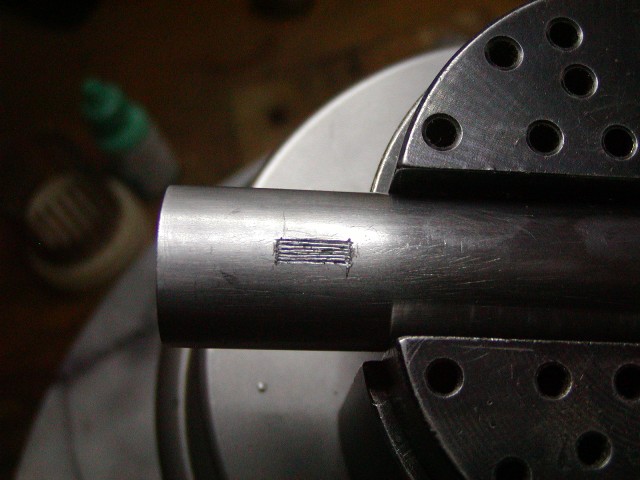
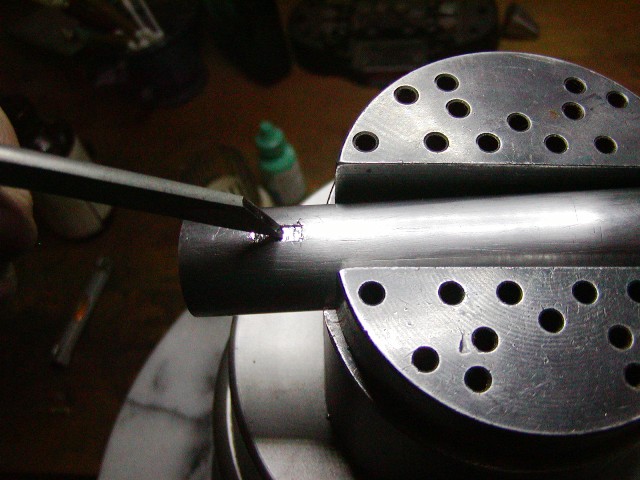
The edges were slightly undercut, then a lug made with a groove filed all the way round its bottom. The lug is tapped into the mortice and then a punch is used to peen the barrel metal into that groove locking the lug in place.
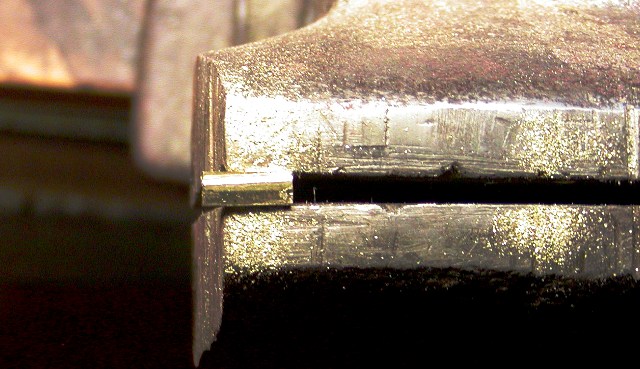
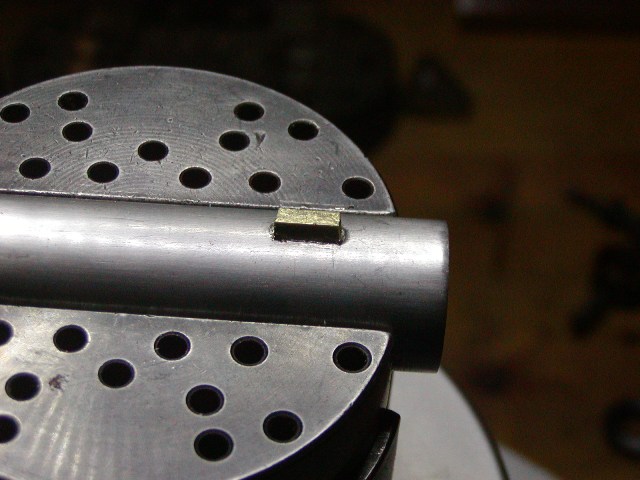
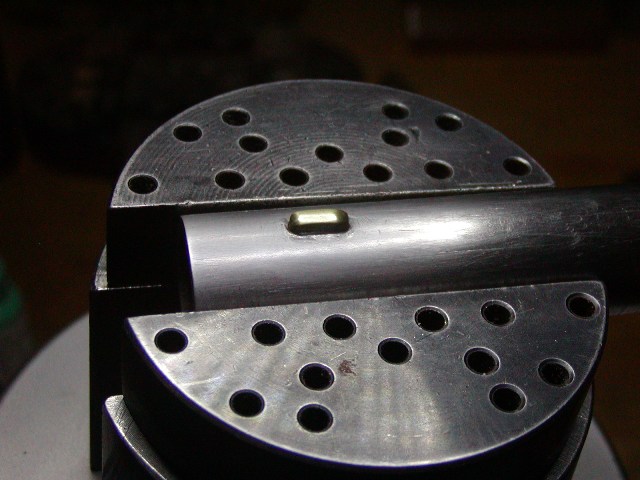
It is very secure and the mortice is shallower than a typical dove tailed slot. This may look challenging but it really is not hard and I can install lugs faster this way than making a dove tailed slot and dove tailed lug. The other thing is the lugs are usually wide, sometimes 1/4" or more so there is quite a bit of metal over which the barrel key slides. This allows a very precise fitting for the key such that it moves smoothly with firm pressure.
dave
Very good observation. On thin walled fowler barrels they often brazed or soldered on lugs but Wogdon and most of the pistol makers cut a very shallow mortice in the barrel as I am doing here for a front sight.


The edges were slightly undercut, then a lug made with a groove filed all the way round its bottom. The lug is tapped into the mortice and then a punch is used to peen the barrel metal into that groove locking the lug in place.



It is very secure and the mortice is shallower than a typical dove tailed slot. This may look challenging but it really is not hard and I can install lugs faster this way than making a dove tailed slot and dove tailed lug. The other thing is the lugs are usually wide, sometimes 1/4" or more so there is quite a bit of metal over which the barrel key slides. This allows a very precise fitting for the key such that it moves smoothly with firm pressure.
dave
mhb
40 Cal.
- Joined
- Oct 5, 2011
- Messages
- 492
- Reaction score
- 222
And I feel equally sure that the originals were done in exactly this way. Is it the best way? No likely not but we can be certain the alteration was not done in Wogdon's shop but likely by a gunsmith in the colonies. Uberti was charged with making the sets exactly as the originals and it would have been silly to make a deviation from the originals. There are very good quality photos of the originals available on the net and they show no sign of a wedge so how do you assume the forend was held on to the barrel? By the way the originals as they exist today one has been converted to percussion.
Here is a link to high quality images of the originals.
https://postalmuseum.si.edu/exhibition/alexander-hamilton/dueling-pistols
Thank you for the link to the high-quality photos. It is clear that there is no wedge through the brass extension. However, I doubt that the screw that holds the extension to the barrel is threaded through into the bore in the original. It would have been unnecessary, since the smith doing the work could have simply threaded the existing forward lug, even altering it a bit if he felt it necessary to get sufficient purchase for the screw, or adding another lug of sufficient size in another location if the geometry of the original wasn't correct, without drilling into the bore. Still, unless specific information becomes available on the originals, I can only hold to my objections to the method used in the reproductions - even the Italians need not have slavishly copied a bad bit of work which would not be evident if better means had been substituted.
mhb - MIke
Similar threads
Latest posts
-
WANTED Pedersoli 10ga sxs with screw in chokes
- Latest: Blackpowderart
-
-
-
FOR SALE Cook pistol, Pedersoli with match grade tune
- Latest: No second place
-
-
-
-
-
-










